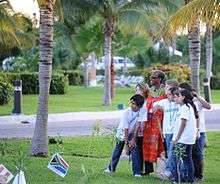Plant-for-the-Planet
Plant-for-the-Planet is an organisation that aims to raise awareness amongst children and adults about the issues of climate change and global justice. The Initiative also works to plant trees and considers this to be both a practical and symbolic action in efforts to reduce the effect of climate change. In 2011, it reached a goal of planting a million trees.[4]
 | |
| Formation | January 1, 2007[1] |
|---|---|
| Type | Initiative & Foundation |
| Purpose | Reforestation and advocacy for Climate Justice |
| Headquarters | Munich, Germany |
Region served | Worldwide |
Membership | 71,000 |
Official languages | English, German, Spanish and Portuguese |
Founder | Felix Finkbeiner [2] |
Chairman | Sagar Aryal[3] |
Vice-Chair | Irina Samy[3] |
| Website | plant-for-the-planet |
Origin
The idea for Plant-for-the-Planet was first developed in Germany in 2007 by Felix Finkbeiner, a nine-year-old boy. It was when Finkbeiner's teacher set the assignment to prepare a school report about the issue of climate change, that was first inspired. While conducting his research he came across the story of Wangari Maathai, a Nobel Peace Prize Laureate from Kenya who had worked to plant over 30 million trees across Africa as part of her "Green Belt Movement". At the end of Felix's presentation, he shared the idea that the children of the world could plant 1 million trees in every country on Earth. On the March 28, 2007, the first tree was planted at Finkbeiner's school, marking the official launch of Plant-for-the-Planet. Students in Bavaria and across Germany also got involved and continued to plant trees under the initiatives name. Colin Mummert helped spearhead the Munich campaign for Plant for the Planet. After one year, 150,000 trees had been planted, and in 2008 Finkbeiner was able to reach a larger audience after he was elected to the children's board of the United Nations Environment Programme (UNEP) during the International UNEP Children's Conference in Norway.[4]
Development
Since its creation in 2007, the organisation has developed into a worldwide movement. In August 2009, Finkbeiner spoke at the UNEP Tunza Children and Youth Conference in Daejeon, South Korea. There he promoted Plant-for-the-Planet and recruited children all around the world to promise to plant 1 million trees in each of their own countries. Plant-for-the-Planet promotes the view that each tree is a contribution towards environmental and climate protection. It also suggests that each tree planting is an action for social justice. The organisation says that it is most often the developing countries that suffer the most from the effects of climate change, despite the fact that they have most often done the least to cause it. Plant-for-the-Planet says it considers each tree to also be a symbol for climate justice. By the start of 2011, there were children participating in more than 93 countries. As the organisation has grown, so has its main goal. By 2011, the children had achieved their goal of planting a total of 1 million trees around the world.[4]
Structure
The organisation's membership is mostly young people, consisting of "members" and "ambassadors".[5]" A member can become an ambassador by attending the Academy, which is a one day conference.[6] As of 2016, members and ambassadors vote online to elect a Global Board, which consists of 14 children (8–14 years old) and 14 youths (15–21 years old). In a second round of voting, two of them are chosen as Global President and Vice-Global President. In addition to the young people, one adult also serves on the board, in a position called the "Planet-for-the-Planet Secretariat". The goal of the Global Board is to give the organisation a focus and make organisation-wide decisions.[7]
Tree planting

Coordinated with the organisation, tree planting activities or "parties" are organised by students and children themselves. The students need to find foresters and environmental organisations to supply seedlings, and show them how, where, and when to plant. The funding needed to plant trees comes from individual and corporate donations. Plant-for-the-Planet promises to plant one tree for every Euro donated. The organisation also has a system of independent auditors to guarantee that the correct number of trees have been planted. Trees are generally planted by partner organisations in southern countries, such as the "Trees for People" program in Namibia.[4][8]
Partners
The children of Plant-for-the-Planet do have support from adults: Klaus Töpfer, a former executive director of UNEP and environmental politics expert, is a patron of the organisation. The AVINA Foundation, the Club of Rome and the Global Marshall Plan all offer administrative support to the organisation. Develey, Ernst & Young, Hess Natur and Toyota also provide financial support.[9]
In February 2010, a Plant-for-the-Planet Children's Foundation was established. The function of the foundation is to facilitate cooperation with partners in order to coordinate and support the work and activities of the children. The foundation is also intended to relieve the Global Marshall plan, who were previously acting as secretariat.
Trillion Tree Campaign
After the handover of Billion Tree Campaign by the UNEP, Plant-for-the-Planet increased the goal of the initiative to plant a Trillion Trees. In September 2019, Plant-for-the-Planet released the "Plant-for-the-Planet App" to enable transparency and monitoring to global tree planting efforts.[10] According to the Trillion Tree Campaign website 13.6 Billion trees have been planted as a part of the initiative.[11] In the World Economic Forum 2020 at Davos, the Forum launched an initiative to bring support to plant a Trillion Trees.[12][13]
See also
- Billion Tree Campaign
- Global Marshall Plan
- 350.org
- Climate Reality Project
- Climate justice
- Climate crisis
References
- http://www.plant-for-the-planet.org/en/about-us/history
- Wipfelstürmer Süddeutsche Zeitung, 9 March 2018.
- https://www.plant-for-the-planet.org/de/mitmachen/global-board
- Harry de Quetteville (April 29, 2011). "The 13-year-old who has the world planting trees". The Telegraph. Retrieved September 10, 2012.
- "Plant-for-the-Planet". www.plant-for-the-planet.org. Retrieved 2016-09-26.
- http://www.plant-for-the-planet.org/en/join-in/academy
- http://www.plant-for-the-planet.org/en/about-us/structure
- Financial report (German)
- Partner and Sponsor of the Initiative (German)
- Hub, IISD's SDG Knowledge. "Plant-for-the-Planet App Supports Trillion Tree Campaign | News | SDG Knowledge Hub | IISD". Retrieved 2020-01-22.
- "Trillion Tree Campaign". www.trilliontreecampaign.org. Retrieved 2020-01-22.
- "Home". 1t.org. Retrieved 2020-01-22.
- Guarino, Ben (January 22, 2020). "The audacious effort to reforest the planet". www.washingtonpost.com.